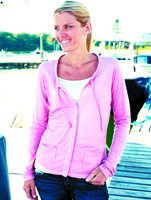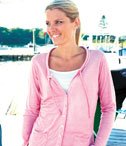From Sheep to Sewing, Ramblers Way Is Made in the U.S.A.
Tom's of Maine founder Tom Chappell was on a chilly hiking trip to Wales when he recognized the need for fine, worsted-wool clothing that is lightweight and can keep people warm without irritating their skin.Ever the entrepreneur, Chappell envisioned a collection of wool clothing manufactured entirely in the United States-from using U.S. wool to knitting, cutting, sewing and dyeing the product in the United States with as little harm done to the environment as possible. quot;Keeping people connected with nature is one of my personal aims,quot; said Chappell, who still lives in Kennebunk, Maine, where Tom's of Maine was born. quot;When you make products out of nature, people feel more connected to nature.quot;Also, Chappell was disturbed to see the way the textile industry had shrunk in the United States. His father had been in the woolen business, having worked for Roger Milliken at Milliken & Co. Chappell remembers the days of robust production. quot;I have been unhappy we've lost our textile industry over the decades,quot; he said.So, a few years ago, the man from Maine started doing some research and found that Rambouillet sheep, raised in the United States, produce a fine wool similar to the finest grades of Merino wool. A little more research and consultation with a fashion designer, and Ramblers Way, a line of men's and women's soft wool apparel and underwear, was born in October 2009.Western wool The company buys its wool from about 10 ranches in Montana, Idaho, Texas and Nevada, getting long-fiber wool that currently costs about $7 a pound, double what it cost when the company started buying wool in 2009. (Flooding and drought in Australia, the world's largest producer of wool, have pushed global wool prices up.) Then the wool is scoured, spun and knitted in mills in South Carolina and North Carolina before being shipped to Fall River, Mass., south of Boston, to be cut and sewn.
From there, it travels to Maine, where the company's natural-dye house, in Saco, eight miles north of Kennebunk, opened one year ago. The company shuns petroleum-based dyes, using plant-based dyes such as madder, indigo, logwood, chestnut, pomegranate, cutch and osage to create the collection's colors.The washable line of henleys, turtlenecks, hoodies, tank tops, camisoles, V-neck tops, short-sleeved polos, long johns and loungewear retails for $100 to $300 and sells primarily to customers between the ages of 35 and 65. quot;I think the baby boomer is our customer, but, on the other hand, the values for sustainability are very strong with a younger adult, particularly a younger professional,quot; Chappell said.Building a sustainable company has always been on the top of Chappell's to-do list. The main office, located in a 1790 structure, has a geothermal and solar system. The same thing goes for the Chappell family home nearby. quot;We really go the extra mile to operate with a clean carbon footprint,quot; Chappell said.
Last year, the first full year the company was in business, revenues totaled $350,000. This year, revenues are expected to more than double, Chappell said.Retail from East to West The label is now stocked by more than 230 stores, mostly on the East Coast and in the Midwest. One of the early adopters of the line was Bergdorf Goodman in New York.
Yet Ramblers Way is making inroads on the West Coast, primarily in affluent California communities such as Newport Beach and Carmel, as well as areas around San Francisco.quot;We love Ramblers Way for its comfort, style, beauty and rich colors,quot; said Heather Wright, manager of Upstairs at Pierre Lefond, a high-end boutique in Montecito, Calif. quot;We are also appreciative of the company's commitment to create an American-made, natural product while respecting the environment. Those qualities make it unique in today's fast-clothing market.quot;
J. Lawrence Khaki's Men's Clothier in Carmel-by-the-Sea, Calif., has been stocking the line in its 12,000-square-foot store since June. quot;They certainly have this perspective of doing things naturally,quot; said Jim Ockert, co-owner of the store. quot;It is a great little layering piece, and they focus on quality and getting the right color. It has a niche.quot;

























